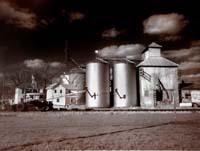
When one’s livelihood is the land, the land is a source of richness and a source of impoverishment. If the rains come on time, if it doesn’t flood; if the last frost is not too late, and the first frost too early; if excessive heat doesn’t destroy the corn’s germination, or too little heat encourage rot… Even with all the mechanization and chemistry in the world, farming is a risky endeavor. Even without the vagaries of markets and federal policy that can make a bumper crop a disaster.
Last year, 2000, for example, everything went right: Farmers were able to plant without the ground being too muddy, or too dry. Rains were plentiful, the temperatures not too hot when the corn tasseled, so the ears filled out, and fall was dry, so the harvest went easily. Bumper crop. The elevators and grain bins couldn’t hold the plenty, and it stood stored in great heaps on the ground. The price of corn fell to under $1.70 a bushel; soybeans under $4.50.
These photographs are not about nostalgia, a sentiment all too often applied to the rural landscape. There’s something deeply wrong about the landscape we drive through. But it’s a wrongness that doesn’t admit to easy diagnosis and even less to easy remedy. Virtually every commentator notes it:
continued
Last year, 2000, for example, everything went right: Farmers were able to plant without the ground being too muddy, or too dry. Rains were plentiful, the temperatures not too hot when the corn tasseled, so the ears filled out, and fall was dry, so the harvest went easily. Bumper crop. The elevators and grain bins couldn’t hold the plenty, and it stood stored in great heaps on the ground. The price of corn fell to under $1.70 a bushel; soybeans under $4.50.
These photographs are not about nostalgia, a sentiment all too often applied to the rural landscape. There’s something deeply wrong about the landscape we drive through. But it’s a wrongness that doesn’t admit to easy diagnosis and even less to easy remedy. Virtually every commentator notes it:
continued


| PAGE |<< | 1 | 2 | 3 | 4 | 5 | 6 | 7 | 8 | 9 | 10 | | 11 | 12 | 13 | 14 | 15 | 16 | 17 | 18 | 19 | 20 | |
||
| D. Gorton's Home Page Jane Adams' Home Page Memory and Judgment: Mississippi The White South Contact Us |
|||||||||
|
This page was last modified on:
|
|||||||||